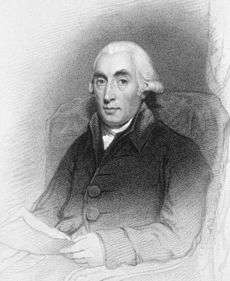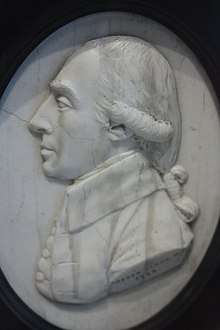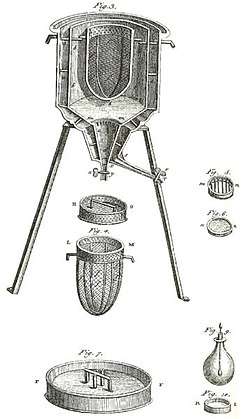Joseph Black
| Joseph Black | |
|---|---|
 | |
| Born |
16 April 1728 Bordeaux, France |
| Died |
6 December 1799 (aged 71) Edinburgh, Scotland |
| Nationality | Scottish |
| Alma mater |
University of Glasgow University of Edinburgh |
| Known for | Latent heat, specific heat, and the discovery of carbon dioxide |
| Scientific career | |
| Fields | Medicine, physics, chemistry |
| Institutions | University of Edinburgh |
| Academic advisors | William Cullen |
| Notable students |
James Edward Smith Thomas Charles Hope |
| Influenced | James Watt, Benjamin Rush[1] |

Joseph Black (16 April 1728 – 6 December 1799) was a Scottish physician and chemist, known for his discoveries of magnesium, latent heat, specific heat, and carbon dioxide. He was Professor of Anatomy and Chemistry at the University of Glasgow for 10 years from 1756, and then Professor of Medicine and Chemistry at the University of Edinburgh from 1766, teaching and lecturing there for more than 30 years.[2]
The chemistry buildings at both the University of Edinburgh and the University of Glasgow are named after Black.
Early life and education
Black was born in Bordeaux, France, the sixth of the 12 children of Margaret Gordon (d. 1747) and John Black. His mother was from an Aberdeenshire family that had connections with the wine business and his father was from Belfast, Ireland and worked as a factor in the wine trade.[3] He was educated at home until the age of 12, after which he attended grammar school in Belfast. In 1746 at the age of 18 he entered the University of Glasgow, studying there for four years before spending another four at the University of Edinburgh, furthering his medical studies. During his studies he wrote a doctorate thesis on the treatment of kidney stones with the salt magnesium carbonate.[4]
Work
Chemical Principles
Like most 18th-century experimentalists, Black's conceptualisation of chemistry was based on five 'principles' of matter: Water, Salt, Earth, Fire and Metal.[5] He added the principle of 'Air' when his experiments definitely confirmed the presence of carbon dioxide, which he called 'fixed air'. Black's research was guided by questions relating to how the 'principles' combined with each other in various different forms and mixtures. He used the term 'affinity' to describe the force that held such combinations together.[6] Throughout his career he used a variety of diagrams and formulas to teach his University of Edinburgh students how to manipulate 'affinity' through different kinds of experimentation.[7]
Analytical balance
In about 1750, while still a student, Black developed the analytical balance based on a light-weight beam balanced on a wedge-shaped fulcrum. Each arm carried a pan on which the sample or standard weights was placed. It far exceeded the accuracy of any other balance of the time and became an important scientific instrument in most chemistry laboratories.[8]
Latent heat

In 1757, Black was appointed Regius Professor of the Practice of Medicine at the University of Glasgow.
In 1761 he deduced that the application of heat to ice at its melting point does not cause a rise in temperature of the ice/water mixture, but rather an increase in the amount of water in the mixture. Additionally, Black observed that the application of heat to boiling water does not result in a rise in temperature of a water/steam mixture, but rather an increase in the amount of steam. From these observations, he concluded that the heat applied must have combined with the ice particles and boiling water and become latent.[9]
The theory of latent heat marks the beginning of thermodynamics.[10] Black's theory of latent heat was one of his more-important scientific contributions, and one on which his scientific fame chiefly rests. He also showed that different substances have different specific heats.
The theory ultimately proved important not only in the development of abstract science but in the development of the steam engine.[11] The latent heat of water is large compared with many other liquids, so giving impetus to James Watt's attempts to improve the efficiency of the steam engine invented by Thomas Newcomen. Black and Watt became friends after meeting around 1757 while both were at Glasgow. Black provided significant financing and other support for Watt's early research in steam power.
Carbon dioxide
Black also explored the properties of a gas produced in various reactions. He found that limestone (calcium carbonate) could be heated or treated with acids to yield a gas he called "fixed air." He observed that the fixed air was denser than air and did not support either flame or animal life. Black also found that when bubbled through an aqueous solution of lime (calcium hydroxide), it would precipitate calcium carbonate. He used this phenomenon to illustrate that carbon dioxide is produced by animal respiration and microbial fermentation.
Professorship
In 1766, treading in the footsteps of his friend and former teacher at the University of Glasgow, Black succeeded William Cullen as Professor of Medicine and Chemistry at the University of Edinburgh (Cullen had moved to Edinburgh in 1755). His position at Glasgow University was filled by Alexander Stevenson.[12]
At this point he gave up research and devoted himself exclusively to teaching. In this he was successful with audience attendance at his lectures increasing from year to year for more than thirty years. His lectures had a powerful effect in popularising chemistry and attendance at them even came to be a fashionable amusement.
Black was widely recognised as one of the most popular lecturers at the University. His chemistry course regularly attracted an exceptionally high number of students, with many attending two or three times. In addition to regularly introducing cutting-edge topics and meticulously selecting visually impressive experiments, Black employed a wide array of successful teaching tools that made chemistry accessible to his students (many of whom were as young as 14 years old).[13][14] His students came from across the United Kingdom, its colonies and Europe, and hundreds of them preserved his lectures in their notebooks and disseminated his ideas after they left university.
On 17 November 1783 he became one of the founders of the Royal Society of Edinburgh.[15] From 1788 to 1790 he was President of the Royal College of Physicians of Edinburgh.[16] He was a member of the revision committee for the editions of the college's Pharmacopoeia Edinburgensis of 1774, 1783, and 1794. Black was appointed principal physician to King George III in Scotland.
Black's research and teaching were reduced as a result of poor health. From 1793 his health declined further and he gradually withdrew from his teaching duties. In 1795, Charles Hope was appointed his coadjutor in his professorship, and in 1797 he lectured for the last time.
Personal life

Black was a member of The Poker Club and associated with David Hume, Adam Smith, and the literati of the Scottish Enlightenment. He was also close to pioneering geologist James Hutton.
In 1773 he is listed as living on College Wynd on the south side of the Old Town.[17]
Black never married. He died peacefully at his home in Edinburgh in 1799 at the age of 71 and is buried in Greyfriars Kirkyard. The large monument lies in the sealed section to the south-west known as the Covenanter's Prison.
In 2011, scientific equipment believed to belong to Black was discovered during an archaeological dig at the University of Edinburgh.[18]
See also
References
- ↑ John Gribbin (2002) Science: A History 1543–2001.
- ↑ Guerlac, Henry (1970–80). "Black, Joseph". Dictionary of Scientific Biography. 2. New York: Charles Scribner's Sons. pp. 173–183. ISBN 978-0-684-10114-9.
- ↑ Lenard, Philipp (1950). Great Men of Science. London: G. Bell and Sons. p. 129. ISBN 0-8369-1614-X. (Translated from the second German edition.)
- ↑ Antonis Modinos (15 October 2013). From Aristotle to Schrödinger: The Curiosity of Physics. Springer International Publishing. p. 134. ISBN 978-3-319-00749-6.
- ↑ Eddy, Matthew Daniel (2008). John Walker, Chemistry and the Edinburgh Medical School, 1750-1800. London: Routledge.
- ↑ Eddy, Matthew Daniel (2014). "How to See a Diagram: A Visual Anthropology of Chemical Affinity". Osiris. 29: 178–196. doi:10.1086/678093.
- ↑ Eddy, Matthew Daniel. "Useful Pictures: Joseph Black and the Graphic Culture of Experimentation". in Robert G. W. Anderson (Ed.), Cradle of Chemistry: The Early Years of Chemistry at the University of Edinburgh (Edinburgh: John Donald, 2015), 99-118.
- ↑ "Equal Arm Analytical Balances". Retrieved 8 March 2008.
- ↑

- ↑ Ogg, David (1965). Europe of the Ancien Regime: 1715–1783. Harper & Row. pp. 117 and 283.
- ↑ Ogg, David (1965). Europe of the Ancien Regime: 1715–1783. Harper & Row. p. 283.
- ↑ Medical and Philosophical Commentaries 1792
- ↑ Eddy, Matthew Daniel (2014). "How to See a Diagram: A Visual Anthropology of Chemical Affinity". Osiris: 178–196. doi:10.1086/678093.
- ↑ Eddy, Matthew Daniel. 'Useful Pictures: Joseph Black and the Graphic Culture of Experimentation', in Robert G. W. Anderson (Ed.), Cradle of Chemistry: The Early Years of Chemistry at the University of Edinburgh. Edinburgh: John Donald. pp. 99–118.
- ↑ http://www.royalsoced.org.uk/cms/files/fellows/biographical_index/fells_indexp1.pdf
- ↑ "College Fellows: curing scurvy and discovering nitrogen". Royal College of Physicians in Edinburgh. Retrieved 4 November 2015.
- ↑ Edinburgh Post Office directory 1773
- ↑ "Dig finds treasured tools of leading 18th century scientist". The Scotsman. 28 June 2011. Archived from the original on 18 April 2012.
Further reading
- Ramsay, William (1918). The Life and Letters of Joseph Black. London: Constable – via Internet Archive.
- "JOSEPH BLACK and the discovery of carbon dioxide". The Medical Journal of Australia. 44 (23): 801–2. June 1957. PMID 13440275.
- "Joseph Black—rediscoverer of fixed air". JAMA. 196 (4): 362–3. April 1966. doi:10.1001/jama.196.4.362. PMID 5325596.
- Breathnach CS (October 1999). "Irish links of the multinational chemist Joseph Black (1728–1799)". Journal of the Irish Colleges of Physicians and Surgeons. 28 (4): 228–31. PMID 11624012.
- Breathnach CS (August 2000). "Joseph Black (1728–1799): an early adept in quantification and interpretation". Journal of Medical Biography. 8 (3): 149–55. PMID 10954923.
- Buchanan WW, Brown DH (June 1980). "Joseph Black (1728–1799): Scottish physician and chemist". The Practitioner. 224 (1344): 663–6. PMID 6999492.
- Buess H (1956). "[Joseph Black (1728–1799) and the original chemical experimental research in biology and medicine]". Gesnerus (in German). 13 (3–4): 165–89. PMID 13397909.
- Donovan A (November 1978). "James Hutton, Joseph Black and the chemical theory of heat". Ambix. 25 (3): 176–90. doi:10.1179/000269878790223935. PMID 11615707.

- Eklund JB, Davis AB (October 1972). "Joseph Black matriculates: medicine and magnesia alba". Journal of the History of Medicine and Allied Sciences. 27 (4): 396–417. doi:10.1093/jhmas/xxvii.4.396. PMID 4563352.
- FOREGGER R (1957). "Joseph Black and the identification of carbon dioxide". Anesthesiology. 18 (2): 257–64. doi:10.1097/00000542-195703000-00011. PMID 13411612.
- FRACKELTON WG (November 1953). "Joseph Black and some aspects of medicine in the eighteenth century". The Ulster Medical Journal. 22 (2): 87–99. PMC 2479821. PMID 13136576.
- GUERLAC H (December 1957). "Joseph Black and fixed air. II". Isis. 48 (154): 433–56. doi:10.1086/348610. PMID 13491209.
- Lenard, Philipp (1950). Great Men of Science. London: G. Bell and Sons. p. 129. ISBN 0-8369-1614-X.
- Perrin CE (November 1982). "A reluctant catalyst: Joseph Black and the Edinburgh reception of Lavoisier's chemistry". Ambix. 29 (3): 141–76. doi:10.1179/000269882790224551. PMID 11615908.
- Ramsay, William (1905). The Gases of the Atmosphere. London: Macmillan.
